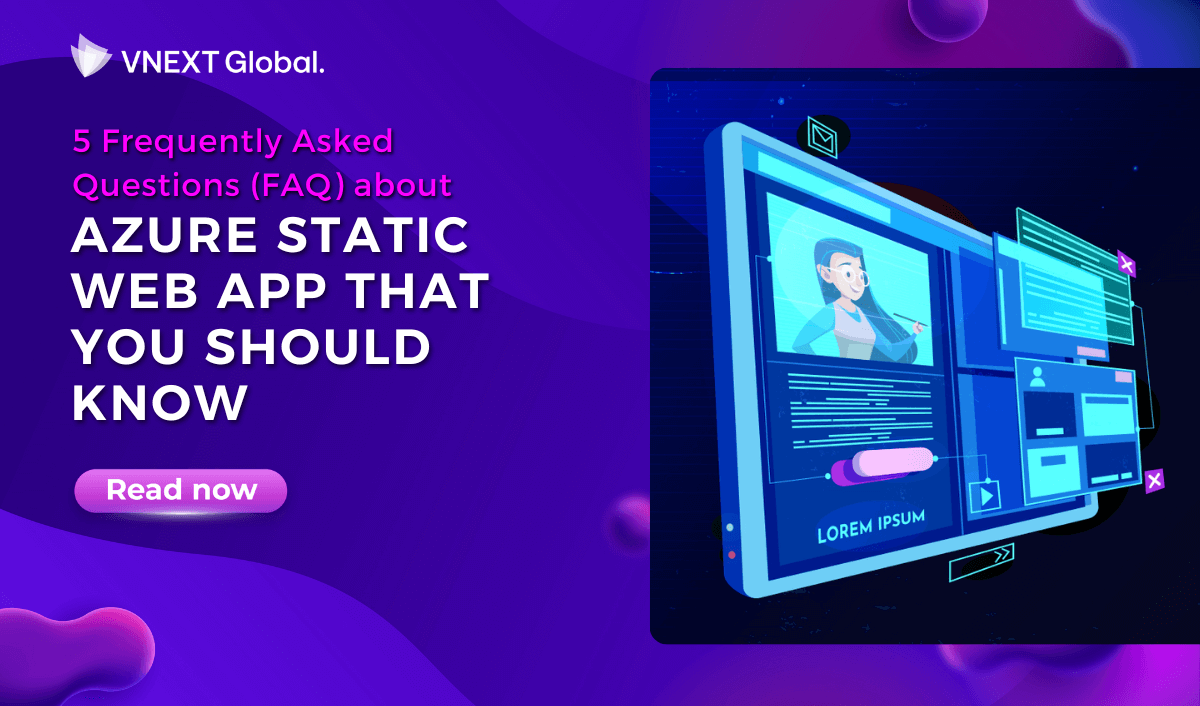For developers accustomed to hosting web applications on Internet Information Services, creating static web applications to be hosted on Azure Web Apps is a familiar process (IIS). Local application development can be performed with ASP.NET, Java, Node.js, PHP, and Python, and can be quickly deployed to Azure Web Apps. The platform provides continuous deployment to several staging environments, allowing development teams to rapidly and reliably deliver application upgrades.
Despite the immense benefits that Azure web apps provide, few developers and decision-makers have a comprehensive understanding of this area. In this article, we've collected the five most frequently asked questions about this issue and offered in-depth responses to each. Let's get started.
1. What is a static web app in Azure?
.png)
To understand Azure's static web app, you must first have a general understanding of Azure Web Apps. Azure App Service Web Apps (previously Azure Websites) is a platform-as-a-service (PaaS) product that enables developers to create mission-critical, highly scalable, and secure web applications. To write code, developers can choose from languages such as C#, HTML5, PHP, Java, Node.js, and Python and use familiar tools such as Visual Studio and platform-specific Azure SDKs.
Azure static web application is a subtype of Azure web application. Modern online application service that allows optimized full-stack development, from source code to global high availability. By leveraging Git Hub and DevOps repositories, Azure static web apps may build and deploy whole web applications in the Azure platform (through a serverless Azure API).
2. How much does it cost to host an app on Azure?
.png)
It is difficult to provide a concise answer to this question because the price range for hosting an application on Azure is quite variable. It depends on the computational power and storage (vPU, RAM, etc.), as well as the number of hours you would require these resources.
Azure hosting fees vary based on the desired service level, however, the average monthly cost for hosting a small website on Azure is approximately $5.50.
For a static website on Microsoft Azure, the monthly plan costs between $0.5 and $2, which is considered the lowest cost for a web application on Azure.
A dynamic website uses more resources and is more expensive than a static website. Any website with dynamic content would require server-side programming. Azure App Service can be used to get started. If you are interested in shared infrastructure, you can obtain ten free websites with limited CPU and storage space.
If your website receives more visitors, you will require more resources to manage it. This necessitates the acquisition of additional CPU and storage, which might cost up to $50 per month. In summary, the free tier will not suffice, and you must pay attention to the other tiers, such as the basic, standard, etc.
3. Can I build a free web app on Azure?
.png)
Yes, it is possible to build a free Azure web app using Microsoft's free plan. Azure has two sorts of plans for users to choose from: Free and Standard (Paid). As the Free plan's app size is only 250 MB per app and staging environments are only 3 MB, it is more suited for small or personal projects that do not require a large app size and staging environments.
Along with this 250MB app, you also receive API management through Azure Functions and authentication provider integration that has been preset. In addition, the Free-tier plan excludes features such as providing custom roles to a function, Private endpoints, and Service Level Agreement (SLA).
Therefore, if you need more than three staging environments, official customer support, security requirements that necessitate a custom provider registration, and ample storage space, the free-tier plan is not a good fit. However, as previously noted, the Azure web app free plan is highly recommended if you're considering using it for a personal project.
4. Can I use Azure free forever?
.png)
Azure is not free forever, unfortunately. Microsoft has been previously generous with the number of free offerings. Azure Web Sites, Azure SQL Database, and Azure Storage are all available without cost.
However, Microsoft recently stated it will begin charging for certain Azure functions. Included in these features are storage, computation, and networking.
One hour of computer time and 100 GB of data consumption will be charged for storage.
There are certain exceptions to these fees. The first is that only new clients will be subject to these fees. Existing clients will not be affected.
The second is that only paying clients are subject to these fees. Microsoft has also said that it will continue to provide Office 365, Azure Active Directory, and Azure Automation free of charge.
Azure remains a rich platform overall. Microsoft has stated that it would start charging for some functions, while the majority of its services remain free.
5. How do I launch my Azure web application at no cost?
- Pre-conditions
- GitHub profile
- Microsoft Azure account
Building apps from a GitHub repository, Azure Static Web Apps distributes a website to a production environment.
- Deploy Azure Web App
- Create a static web application
After creating your GitHub repository and committing your code, you may use the Azure portal to construct a static web application.
Visit the Azure Portal and select Develop a Resource Lookup for Static Web Applications
Choose Static Web Applications Create
Start by setting your new app and attaching it to a GitHub repository under the Basics section.
- Select your Azure Subscription
- Choose or create an appropriate Resource Group
- Name the application as you see fit (e.g. my-first-static-web-app)
- The valid characters are a-z (without regard to case), 0-9, and -.
- Select the Region nearest you
- Choose the Free SKU
- Select the GitHub Sign-In button and authenticate with GitHub.
After logging into GitHub, input the repository's details.
- Choose an Organization
- Choose your repository from the drop-down menu titled Repository.
- Choose your production branch from the drop-down menu titled Branch.
- Add setup information for building your Gridsome website in the Build Details section.
- In our scenario, we are able to use Vue.js because Gridsome uses the same structure.
- Keep the default value for the Location of the App box
- Remove the default value from the API location field
- Maintain the default App artifact location value
Final Thoughts:
If you are looking for a trusted IT partner, VNEXT Global is the ideal choice. With 14+ years of experience, we surely can help you to optimize your business digitalization within a small budget and short time. Currently, we have 400+ IT consultants and developers in Mobile App, Web App, System Development, Blockchain Development and Testing Services. We have provided solutions to 600+ projects in several industries for clients worldwide. We are willing to become a companion on your way to success. Please tell us when is convenient for you to have an online meeting to discuss this further. Have a nice day!












